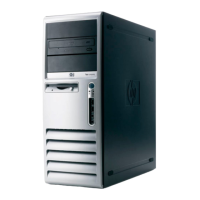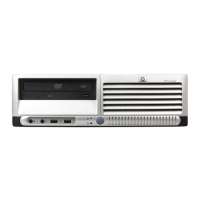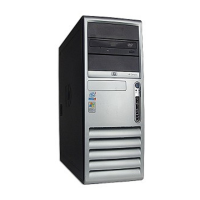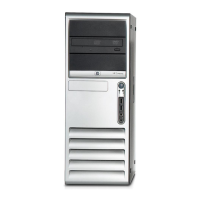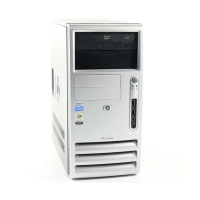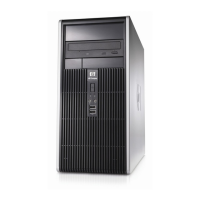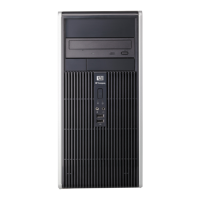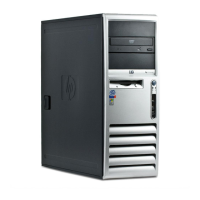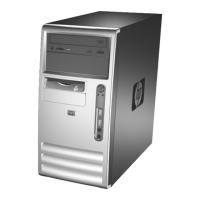3-4 www.hp.com Technical Reference Guide
Processor/Memory Subsystem
3.3 Memory Subsystem
All models support PC2-4200 DDR2 (533-MHz) memory. The USDT form factor supports up to
3 gigabytes of memory while the SFF, ST, MT, and CMT form factors support up to 4 gigabytes
of memory.
✎
The DDR SDRAM “PCxxxx” reference designates bus bandwidth (i.e., a PC2700 DIMM can,
operating at a 333-MHz effective speed, provide a throughput of 2700 MBps (8 bytes ×
333MHz)). Memory speed types may be mixed within a system, although the system BIOS will
set the memory controller to work at speed of the slowest DIMM.
The system board provides three or four DIMM sockets depending on form factor:
■
XMM1, channel A (all form factors
■
XMM2, channel A (not present on USDT form factor)
■
XMM3, channel B (all form factors)
■
XMM4, channel B (all form factors)
DIMMs do not need to be installed in pairs although installation of pairs (an equal DIMM for
each channel) provides the best performance. The BIOS will detect the DIMM population and set
the system accordingly as follows:
■
Single-channel mode - DIMMs installed for one channel only
■
Dual-channel asymetric mode - DIMMs installed for both channels but of unequal channel
capacities.
■
Dual-channel interleaved mode (recommended)- DIMMs installed for both channels and
offering equal channel capacities, proving the highest performance.
These systems support DIMMs with the following parameters:
■
Unbuffered, compatible with SPD rev. 1.0
■
256-Mb, 512-Mb, and 1-Gb memory technologies for x8 and x16 devices
■
CAS latency (CL) of 4
■
Single or double-sided
■
Non-ECC memory only
The SPD format supported by these systems complies with the JEDEC specification for 128-byte
EEPROMs. This system also provides support for 256-byte EEPROMs to include additional
HP-added features such as part number and serial number. The SPD format as supported in this
system (SPD rev. 1) is shown in Table 3-1.
If BIOS detects an unsupported DIMM, a “memory incompatible” message will be displayed
and the system will halt. These systems are shipped with non-ECC DIMMs only. Refer to
chapter 8 for a description of the BIOS procedure of interrogating DIMMs.
An installed mix of DIMM types is acceptable but operation will be constrained to the level of
the DIMM with the lowest (slowest) performance specification.
If an incompatible DIMM is detected the NUM LOCK will blink for a short period of time
during POST and an error message may or may not be displayed before the system hangs.
